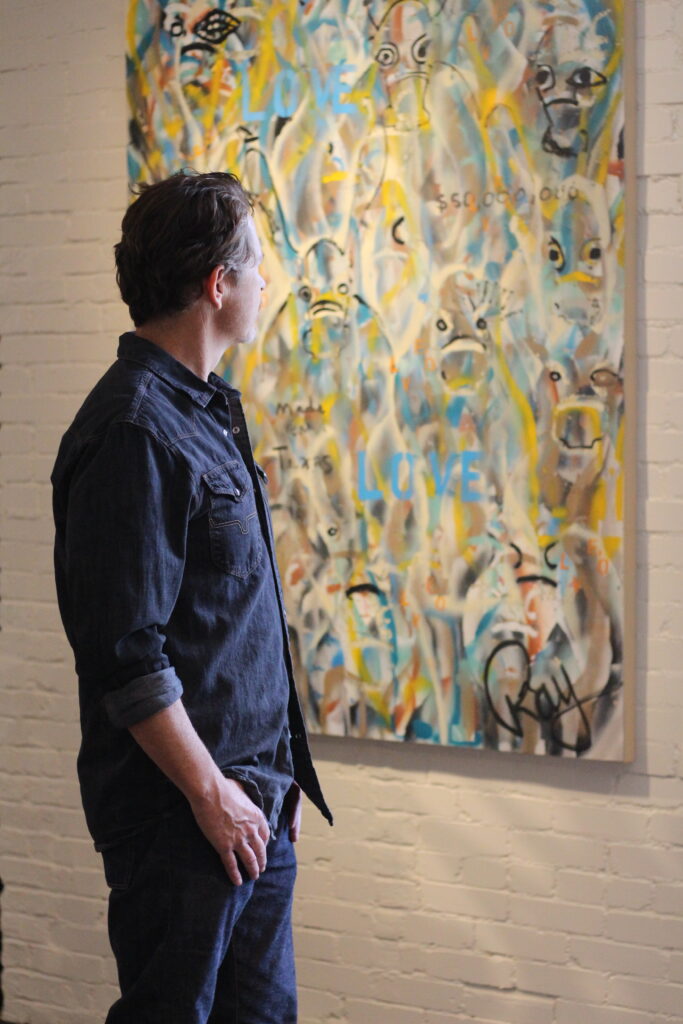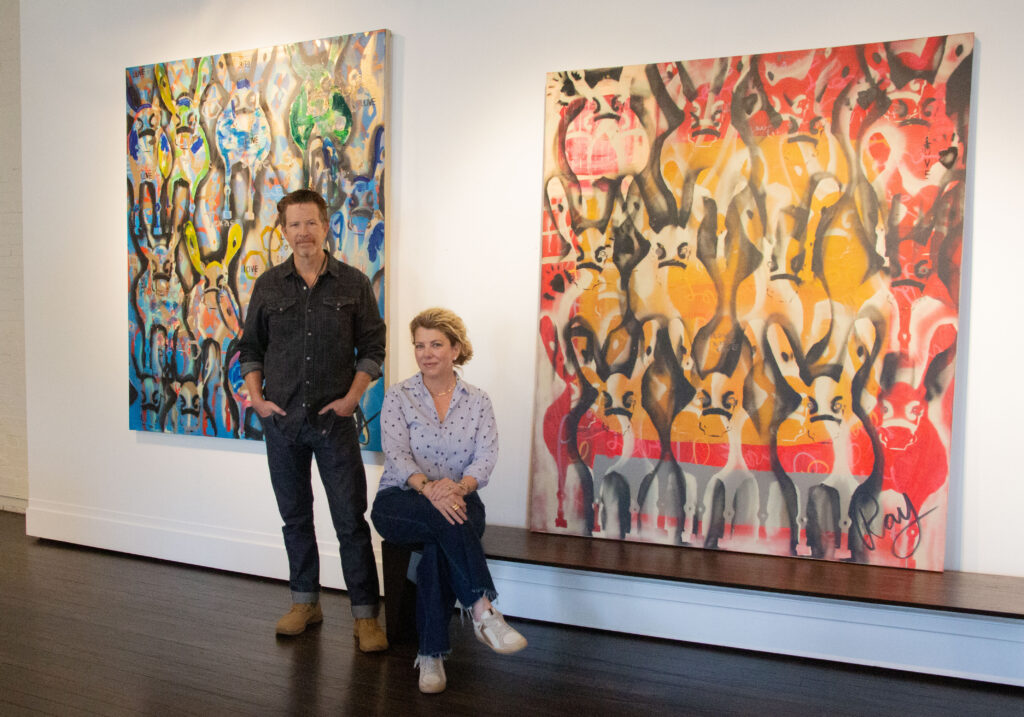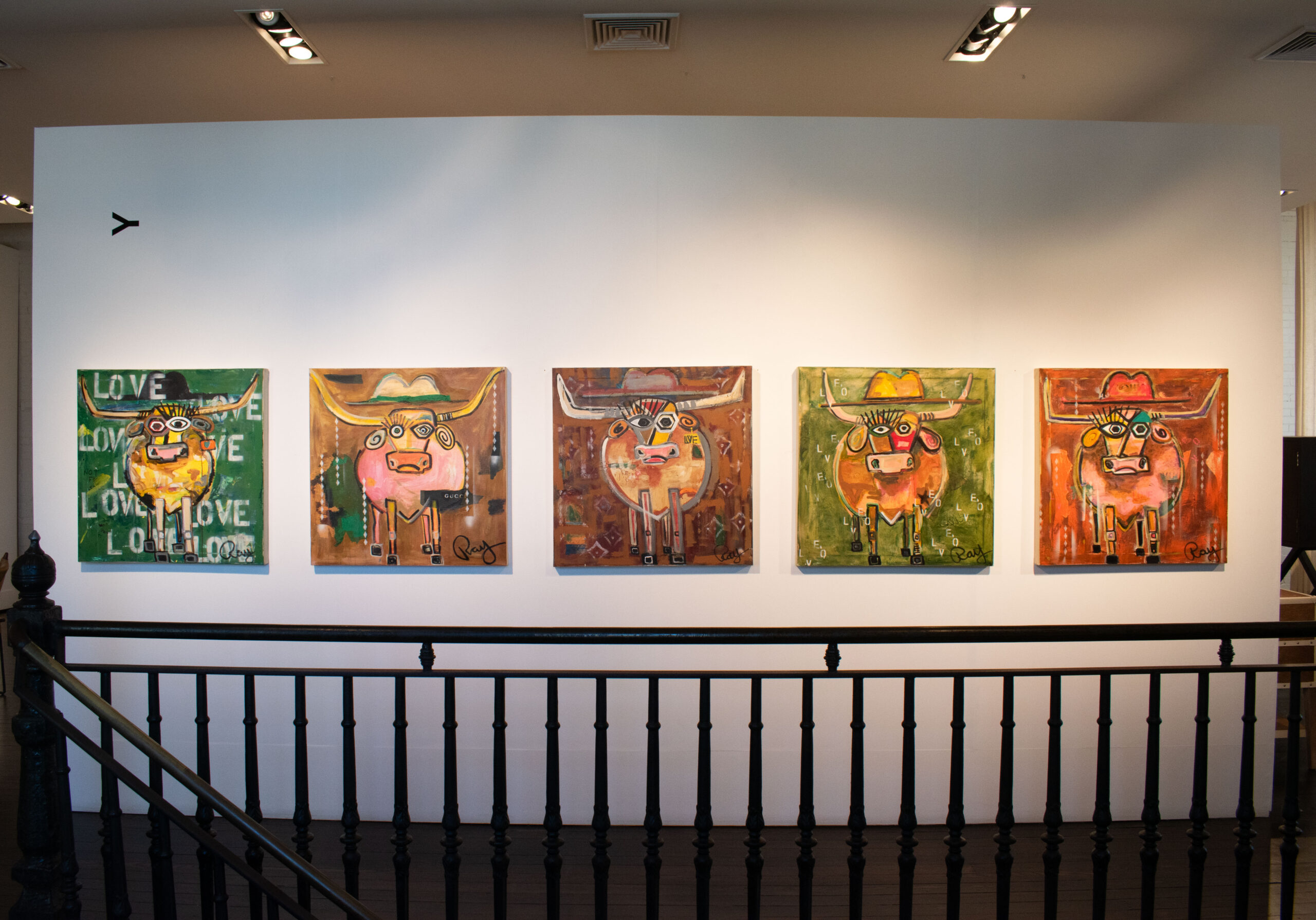The Art of Ray Hadaway
By Lauren Elizabeth Shults
Paintings by Ray Hadaway prod at the classic image of ranching culture in technicolor, with abstract portraits that unfurl handsome cowboy tales.
Hadaway plays the jester while creating his cowboys and cowgirls (which, his wife Meredith says, are more popular). They have rouged cheeks, bright lips and wide, ringed eyes, sometimes shaped as squares or hexagons.
Hadaway describes his work as “light-hearted and not overly serious. People can relate to that.” He’s serious in practice, but not necessarily in subject.
Other works in his debut Vaudeville Gallery show, “Scene and Herd,” are a tangle of longhorns or jackrabbits filling a canvas. They’re inexact, without their bodies fully visible, and tags dangle from their ears like earrings.
All the eyes are on the individual paintings of cows, much like the attention given in a pageant or fashion show, Hadaway said. “Bonnie,” and “Clyde,” are the main characters and hosts of the show, he said, the groups of donkeys and longhorns onlookers.
“That’s how I imagined it in my head,” Hadaway said about capturing the feeling of Fredericksburg and Vaudeville’s Gallery space.
But even being a show, his characters have no semblance of grace. They’re all merely characters in the painter’s satire, with inexact proportions and vibrant coloring.
The Brenham-based artist is a part of what he calls “contemporary folk fusion,” which modernizes traditional western subjects. He juxtaposes classic and current western culture in his works, just as he has seen every day in Texas, growing up in ranching communities across the state.
Characters of an earlier series, “Spaghetti Westerns,” have moustaches and hold snakes — more akin to the wild southwest than to cattle ranching of central and south Texas that he’s migrated toward most recently.
His earliest works had no human presence and were filled to their borders with replications of jackrabbits, burrows, longhorns, or any other wildlife you may find on the range. He most recently painted a collection of goats for a goat breeder.
In the last several months, he’s worked on commissions of turkeys, goats, rabbits, and dogs — all his imaginations of his clients’ animals.
He said every animal featured in a painting is one he’s come across on a ranch, out on the planes or belong to his clients.
His styles are crude, and his graffiti elements are plainly influenced by Jean-Michel Basquiat and neo-expressionism. The animals wear three-pointed crowns as they’re the kings of the land and dictate what so much of what Texas stands for.
For a punch of fun, the steers sometimes have long eyelashes — but only on one side.
“I keep everything super-positive, super-high energy and charged that way,” he said. “I feel like I’m somehow charging the painting with that emotion.”
Hadaway’s recent shift into portraiture focuses more on culture and people of the area, rather than merely its industry.
In these newer works, he makes playful prods at materialism, envisioning pageantry in ranching.
Hadaway layers canvases with remnants of designer labels, paints logos on bandanas and stamps five-digit price tags in backgrounds.
He said he envisioned the works for “Scene and Herd” as a fashion show of sorts: the paintings of all cows the audience, the cowboys on the runway.
It’s more than a jest about the differences between cowboying and the fashion world, though: His late summer 2023 exhibition, “Scene & Herd,” is meditation on the people behind the herds. Unlike traditional western art, these people are not merely a part of a stereotyped scene.
He says he’s sticking with the same themes of the cows and the donkeys and the cowboys for the foreseeable future but will continue to tweak the worlds in which he presents them.
“I’ve always done similar subject matter, but I always come up with new twist for it,” he said. “You’re always taking chances with art, and that’s part of the fun.”

Hadaway’s wife, Meredith Hadaway, is a sculptor of similar subjects: jackrabbits, chickens and cattle have been a few of her collections.
“She’s my ultimate critic. Before it leaves the house, I ask, ‘what are your thoughts,’” he said. “If I feel like she doesn’t like it, then it’s not going out the door.”
His first painting of a per-son was of Meredith. After showing it to her, the two wrapped it up and it’s been in storage since. After his portrait of Meredith, none of his subjects have been specific people. Even though they are distinct characters, they’re amalgamations of people he’s come across in life. “I just wanted them in contemplation of thought,” he said about their placid faces.
They’re very direct, and with that, quietly expressive. They don’t necessarily hold a lot of emotion: the feeling is in the works themselves through color and his countless layers.
There are hot punches of color but he now uses more muted and shaded colors than his previous works. The portraits, although multimedia, come across less experimental and more stylized.
They’re studies of cowboys and cowgirls and how they exist in their environment, the way Hadaway sees them. Their hat brims are always upturned and buckles oversized. The landscape of Texas changing, Main Streets changing, small towns changing, comes through his abstractions.
“Scene and Herd,” pulls from the typical Fredericksburg crowd on a weekend, he and Meredith said. You see ranchers and look-a-like ranchers with “all hat and no cattle.”
“There’s couture that comes through, then you see the guy in boots with Spurs,” Meredith said.
“It’s starting to reach out there and just connect with all kinds of people,” Hadaway said. “That’s what I enjoy about it — making connections with people I’ve never met before.”
His portraits are more than about stylistic aesthetic — they underscore the increasingly foreign look of cowboys in their own communities. But in their arms, the characters all hold miniature animals he’s always painted.
The backgrounds are deep blues, reds and greens with words, numbers, and tessellated patterns of diamonds and stars in the foregrounds.
“I kind of felt jazzy, like a South Texas kind of a country feeling. Then a New Orleans jazz,” he said about his process.
He uses music to connect to thoughts, “and that’s how it comes out.”
“I felt like a conduit to the painting — a connection to them,” he said about the process of making the artworks.
Elements are rolled on, pressed, dripped with wet paints and streaked with dry brushes.
“I like a lot of heavy brushstrokes. I like incorporating the mixed media aspect,” Hadaway said, mentioning his sketches, and using old newspaper and wallpaper. “When you have that piece on your wall, you could sit and be entertained by it.”
Hadaway and Meredith said collectors get a sense of comfort from his work, even if they’re in a metropolitan high-rise apartment.
“There’s always something new, but having art on your wall is still tangible,” he said about incorporating so many media.

His works have gone to homes in London on the Thames, Chile and the Netherlands. They’re in an orthopedic surgeon’s office, even, he said astounded.
“Everybody has a different connection. I find that it means something personal to them that I had never imagined when I painted it,” Hadaway said. “I’m just doing what comes to me naturally, and somehow it’s making a connection with other people. We’re having that kind of connection together.”
“I’ve been in rough situations, I’ve been in bad situations, and I don’t want to bring that kind of energy into the art.”
A combat veteran, people ask Hadaway if he’d ever make art reflecting on his experiences. But he says he wants to focus on love and joy — paintings that make people happy.
“I want to keep art alive. I have had that negativity in my life,” he said, mentioning the devastation of war he experienced and saw. “I tried to steer away from that and tried to bring positivity.
“I tried to focus on and bring love back in because there’s enough hate in the world.”

